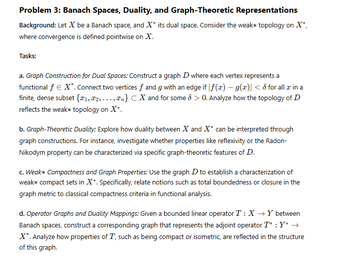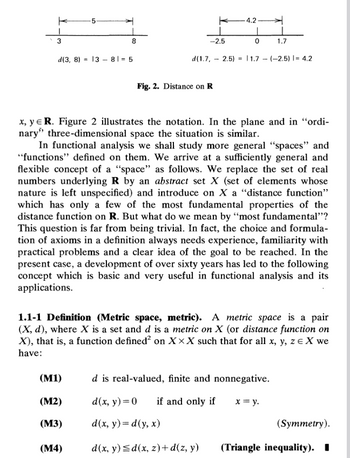
College Algebra
1st Edition
ISBN: 9781938168383
Author: Jay Abramson
Publisher: OpenStax
expand_more
expand_more
format_list_bulleted
Question
thumb_up100%
Make sure to answer by hand, make all graphs and give steps how you constructed these, DO NOT SOLVE USING AI
USE : https://drive.google.com/file/d/1a2B3cDeFgHiJkLmNoPqRsTuVwXyZz0/view?usp=sharing
For the reference, and the book kreyszig can be used,

Transcribed Image Text:Problem 3: Banach Spaces, Duality, and Graph-Theoretic Representations
Background: Let X be a Banach space, and X* its dual space. Consider the weak* topology on X*,
where convergence is defined pointwise on X.
Tasks:
a. Graph Construction for Dual Spaces: Construct a graph D where each vertex represents a
functional ƒ € X*. Connect two vertices ƒ and g with an edge if |f(x) - g(x)| < 6 for all x in a
finite, dense subset {1, 2,..., n} CX and for some 6 > 0. Analyze how the topology of D
reflects the weak* topology on X*.
b. Graph-Theoretic Duality: Explore how duality between X and X* can be interpreted through
graph constructions. For instance, investigate whether properties like reflexivity or the Radon-
Nikodym property can be characterized via specific graph-theoretic features of D.
c. Weak* Compactness and Graph Properties: Use the graph D to establish a characterization of
weak* compact sets in X*. Specifically, relate notions such as total boundedness or closure in the
graph metric to classical compactness criteria in functional analysis.
d. Operator Graphs and Duality Mappings: Given a bounded linear operator T: XY between
Banach spaces, construct a corresponding graph that represents the adjoint operator T* : Y* →
X*. Analyze how properties of T, such as being compact or isometric, are reflected in the structure
of this graph.

Transcribed Image Text:3
K 5
8
K -4.2
-2.5
0
1.7
d(1.7, 2.5) 11.7 (-2.5) |= 4.2
-
=
-
d(3, 8) 13 81-5
Fig. 2. Distance on R
x, y = R. Figure 2 illustrates the notation. In the plane and in “ordi-
nary" three-dimensional space the situation is similar.
In functional analysis we shall study more general "spaces" and
"functions" defined on them. We arrive at a sufficiently general and
flexible concept of a "space" as follows. We replace the set of real
numbers underlying R by an abstract set X (set of elements whose
nature is left unspecified) and introduce on X a "distance function"
which has only a few of the most fundamental properties of the
distance function on R. But what do we mean by "most fundamental"?
This question is far from being trivial. In fact, the choice and formula-
tion of axioms in a definition always needs experience, familiarity with
practical problems and a clear idea of the goal to be reached. In the
present case, a development of over sixty years has led to the following
concept which is basic and very useful in functional analysis and its
applications.
1.1-1 Definition (Metric space, metric). A metric space is a pair
(X, d), where X is a set and d is a metric on X (or distance function on
X), that is, a function defined² on XXX such that for all x, y, z= X we
have:
d is real-valued, finite and nonnegative.
(M1)
(M2)
d(x, y)=0 if and only if
x = y.
(M3)
d(x, y) = d(y, x)
(Symmetry).
(M4)
d(x, y)d(x, z)+d(z, y)
(Triangle inequality). ■
Expert Solution
This question has been solved!
Explore an expertly crafted, step-by-step solution for a thorough understanding of key concepts.
Step by stepSolved in 2 steps with 6 images

Knowledge Booster
Similar questions
- Use the graph of the function of degree 5 in Figure 10 to identify the zeros of the function and their multiplicities.arrow_forward(a) Identifying whether a function is a convex function is useful because a convex function's local minimum has the nice property that it has to be the global minimum. Please select all functions below that are convex functions. Note dom(f ) denotes the domain of the function f . Select all that apply: Of (x) =x3 + 3x + 7, domf ) =R Of (x) Of (x) =|x| , domf ) =R Of (x) =2-X, domf) =R Of =||x|, domf) =R" log x, domf) =R,. (the set of positive real numbers) O None of the above. (b) Typically we can solve linear regression problems in two ways. One is through direct methods, e.g. solving the closed form solution, and the other is through iterative methods (gradi- ent descent). Consider a linear regression on data (X, y). We assume each row in X denotes one input in the dataset. Please select all correct options. Select all that apply: O If the matrix X' x is invertible, the exact solution is always preferred for solving the solution to linear regression as computing matrix inversions and…arrow_forwardInstructions: *Do not Use AI. (Solve by yourself, hand written preferred) * Give appropriate graphs and required codes. * Make use of inequalities if you think that required. *You are supposed to use kreszig for reference. (1.2) Definition: A space X is said to satisfy the T-axiom or is said to be a T-space if for every two distinct points x and y = X, there exists an open set containing x but not y (and hence also another open set contain- ing y but not x). Again, all metric spaces are 7₁. It is obvious that every T₁ space is also To and the space (R, I) above shows that the converse is false. Thus the T₁-axiom is strictly stronger than To. (Sometimes a beginner fails to see any difference between the two conditions. The essential point is that given two distinct points, the To-axiom merely requires that at least one of them can be separated from the other by an open set whereas the T-axiom re- quires that each one of them can be separated from the other.) The following proposition…arrow_forward
- Instructions: *Do not Use AI. (Solve by yourself, hand written preferred) * Give appropriate graphs and required codes. * Make use of inequalities if you think that required. *You are supposed to use kreszig for reference. (1.2) Definition: A space X is said to satisfy the T-axiom or is said to be a T-space if for every two distinct points x and y = X, there exists an open set containing x but not y (and hence also another open set contain- ing y but not x). Again, all metric spaces are 7₁. It is obvious that every T₁ space is also To and the space (R, I) above shows that the converse is false. Thus the T₁-axiom is strictly stronger than To. (Sometimes a beginner fails to see any difference between the two conditions. The essential point is that given two distinct points, the To-axiom merely requires that at least one of them can be separated from the other by an open set whereas the T-axiom re- quires that each one of them can be separated from the other.) The following proposition…arrow_forwardInstructions: *Do not Use AI. (Solve by yourself, hand written preferred) *Give appropriate graphs and required codes. * Make use of inequalities if you think that required. *You are supposed to use kreszig for reference. (1.2) Definition: A space X is said to satisfy the T-axiom or is said to be a T-space if for every two distinct points x and y E X, there exists an open set containing x but not y (and hence also another open set contain- ing y but not x). Again, all metric spaces are T₁. It is obvious that every T₁ space is also To and the space (R, T) above shows that the converse is false. Thus the T₁-axiom is strictly stronger than To. (Sometimes a beginner fails to see any difference between the two conditions. The essential point is that given two distinct points, the To-axiom merely requires that at least one of them can be separated from the other by an open set whereas the T₁-axiom re- quires that each one of them can be separated from the other.) The following proposition…arrow_forwarda*b1/2 0<a<1 0<b<1 whats the Minimum ofarrow_forward
- Using the function f: (-1,2] → R, ƒ (x) = 4x³ – 3x² – 6x + 2, a. Determine all the stationary points within the domain restriction and the nature of each of these turning points b.-Sketch the graph of the function in the space below, indicating the endpoints, y- intercepts, and the turning points. Show calculations for the start and end point in the space below too. ORMITUniversity Page 4 of 7 MM Quiz (2021)arrow_forward3) In the table below, give the approximate x-coordinate of each discontinuity of the nifty function below AND give the discontinuity type (removable, jump, or infinite). The dashed lines are one unit apart. From smallest to biggest (there may be more rows than necessary): Discontinuity at Туреarrow_forwardUse calculus to find the absolute maximum value and the absolute minimum value, if any, of the function. (If an answer does not exist, enter DNE.) f(x) = -x2 + 4x + 10 [4, 7] on Part 1 of 7 Notice that the domain off is (Enter your answer using interval notation.) and ---Select--- a closed interval. Also, the function f --Select--- a continuous function. Submit Skip (you cannot come back).arrow_forward
arrow_back_ios
SEE MORE QUESTIONS
arrow_forward_ios
Recommended textbooks for you
